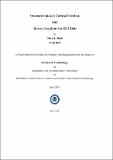| dc.contributor.advisor | Bhise, Minal | |
| dc.contributor.author | Shah, Bhavik | |
| dc.date.accessioned | 2017-06-10T14:42:00Z | |
| dc.date.available | 2017-06-10T14:42:00Z | |
| dc.date.issued | 2014 | |
| dc.identifier.citation | Shah, Bhavik (2014). Structure indexed vertical partition and query execution for RDF data. Dhirubhai Ambani Institute of Information and Communication Technology, viii, 66 p. (Acc.No: T00470) | |
| dc.identifier.uri | http://drsr.daiict.ac.in/handle/123456789/507 | |
| dc.description.abstract | The Semantic Web is an effort by the W3C to enable integration and sharing of data across different applications and organizations. Tremendous growth of organizations and applications across World Wide Web requires the huge web data to be managed effectively. Semantic web data is a Resource Description Framework RDF data. To store and consume this huge amount of RDF data, different partitioning techniques like Property table, Vertical Partition, Horizontal Partition, and Structure Index Partition are explored. This will further help in building interactive semantic web systems. This thesis explores the use of integration of different partitioning techniques.
Structure Indexed Vertical Partition implemented in this work is an integration of Structure Index Partition and Vertical Partition. Structure Indexed Vertical Partition RDF store is built and queries of different complexities are executed on it. Five different metrics to measure and analyze the performance of Structure Indexed Vertical Partition are devised. FOAF and SwetoDBLP datasets are used for experiments and queries are identified for the same. Results show average 45% and 23% gain on query execution time for SIVP data over VP data for FOAF hot runs and cold runs respectively. It also shows average 27% and 25% gain on query execution time for SIVP data over VP data for SwetoDBLP hot runs and cold runs respectively. SIVP technique is better than VP technique provided extra time which consists of lookup time and merge time needed in SIVP technique can be compensated by frequency of a query higher than Breakeven point for that query. The average breakeven point frequency is 97 for hot runs and 40 for cold runs for 14 FOAF dataset queries. The average breakeven point frequency is 200 for hot runs and 78 for cold runs for 10 SwetoDBLP dataset queries. | |
| dc.publisher | Dhirubhai Ambani Institute of Information and Communication Technology | |
| dc.subject | Structure Indexed Vertical Partition | |
| dc.subject | Query Execution | |
| dc.subject | RDF Data | |
| dc.classification.ddc | 005.74 SHA | |
| dc.title | Structure indexed vertical partition and query execution for RDF data | |
| dc.type | Dissertation | |
| dc.degree | M. Tech | |
| dc.student.id | 201211038 | |
| dc.accession.number | T00470 | |

